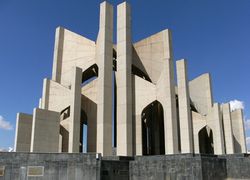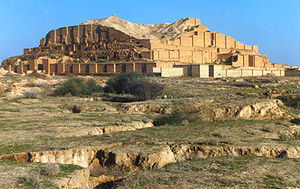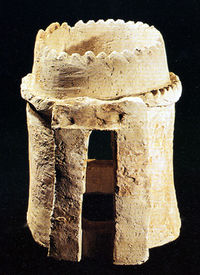Iranian architecture
 |
|
| Persian Arts | |
| Visual Arts | |
| Painting | |
| Miniatures | |
| Decorative Arts | |
| Jewellery | |
| Embroidery | Motifs |
| Tileworks | Handicrafts |
| Pottery | |
| Literature | |
| Literature | Mythology |
| Folklore | |
| Other | |
| Architecture | Cuisine |
| Carpets | Gardens |
| Performance Arts | |
| Dance | Music |
| Cinema | |
Iranian architecture or Persian architecture is the architecture of Greater Iran that has a continuous history from at least 5000 BCE to the present, with characteristic examples distributed over a vast area from Syria to North India and the borders of China, from the Caucasus to Zanzibar. Persian buildings vary from peasant huts to tea houses, and garden pavilions to "some of the most majestic structures the world has ever seen".[1]
Iranian architecture displays great variety, both structural and aesthetic, developing gradually and coherently out of prior traditions and experience. Without sudden innovations, and despite the repeated trauma of invasions and cultural shocks, it has achieved "an individuality distinct from that of other Muslim countries".[2] Its paramount virtues are several: "a marked feeling for form and scale; structural inventiveness, especially in vault and dome construction; a genius for decoration with a freedom and success not rivaled in any other architecture".[3]
Traditionally, the guiding, formative, motif of Iranian architecture has been its cosmic symbolism "by which man is brought into communication and participation with the powers of heaven".[4] This theme, shared by virtually all Asia and persisting even into modern times, not only has given unity and continuity to the architecture of Persia, but has been a primary source of its emotional characters as well.
| “ | "The supreme Iranian art, in the proper meaning of the word, has always been its architecture. The supremacy of architecture applies to both pre-and post-Islamic periods."[5] | ” |
Contents |
Fundamental principles

Traditional Persian architecture has maintained a continuity that, although temporarily diverted by political internal conflicts or foreign intrusion, nonetheless has achieved a style that could hardly be mistaken for any other.
In this architecture, "there are no trivial buildings; even garden pavilions have nobility and dignity, and the humblest caravanserais generally have charm. In expressiveness and communicativity, most Persian buildings are lucid - even eloquent. The combination of intensity and simplicity of form provides immediacy, while ornament and, often, subtle proportions reward sustained observation."[6]
Underlying characteristics
Iranian architecture is based on several fundamental characteristics. These are:[7]
- درونگرایی: Introversion (?)
- نیارش: structure(?)
- پیمون: homogeneous proportions(?)
- مردمواری: anthropomorphism (?)
- جفت و پادجفت: symmetry and anti-symmetry (?)
- پرهیز از بیهودگی: Minimalism (?)
Categorization of styles

Overall, the traditional architecture of the Iranian lands throughout the ages can be categorized into the seven following classes or styles ("sabk"):[8]
- Pre-Islamic:
- The Parsian style (Achaemenid, Median, Elamite eras)
- The Parthian style (Parthian, Sassanid eras)
- Islamic:
- The Khorasani style
- The Razi style
- The Azari style
- The Isfahani style
Materials
Available building materials dictate major forms in traditional Iranian architecture. Heavy clays, readily available at various places throughout the plateau, have encouraged the development of the most primitive of all building techniques, molded mud, compressed as solidly as possible, and allowed to dry. This technique used in Iran from ancient times has never been completely abandoned. The abundance of heavy plastic earth, in conjunction with a tenacious lime mortar, also facilitated the development of the brick.[9]
Geometry
Iranian architecture makes use of abundant symbolic geometry, using pure forms such as the circle and square, and plans are based on often symmetrical layouts featuring rectangular courtyards and halls.
Design

Certain design elements of Persian architecture have persisted throughout the history of Iran. The most striking are a marked feeling for scale and a discerning use of simple and massive forms. The consistency of decorative preferences, the high-arched portal set within a recess, columns with bracket capitals, and recurrent types of plan and elevation can also be mentioned. Through the ages, these elements have recurred in completely different types of buildings constructed for various programs and under the patronage of a long succession of rulers.
The columned porch, or talar, seen in the rock-cut tombs near Persepolis, reappear in Sassanid temples, and in late Islamic times it was used as the portico of a palace or mosque, and adapted even to the architecture of roadside tea-houses. Similarly, the gonbad on four arches, so characteristic of Sassanid times, is a still to be found in many cemeteries and Imamzadehs across Iran today. The notion of earthly towers reaching up toward the sky to mingle with the divine towers of heaven lasted through the 19th century, while the interior court and pool, the angled entrance and extensive decoration are ancient but still common features of Iranian architecture.[6]
Development
Pre-Islamic architecture of Persia (Iran)
- See also: Parthian style (Iranian architecture) & Sassanid architecture
The pre-Islamic styles draw on 3-4 thousand years of architectural development from various civilizations of the Iranian plateau. The post-Islamic architecture of Iran in turn, draws ideas from its pre-Islamic predecessor, and has geometrical and repetitive forms, as well as surfaces that are richly decorated with glazed tiles, carved stucco, patterned brickwork, floral motifs, and calligraphy.
As such, Iran ranks seventh in the world in terms of possessing historical monuments, museums, and other cultural attractions[10] and is recognized by UNESCO as being one of the cradles of civilization.[11]

Each of the periods of Elamites, Achaemenids, Parthians, and Sassanids were creators of great architecture that over the ages has spread wide and far to other cultures being adopted. Although Iran has suffered its share of destruction, including Alexander The Great's decision to burn Persepolis, there are sufficient remains to form a picture of its classical architecture.
The Achaemenids built on a grand scale. The artists and materials they used were brought in from practically all territories of what was then the largest state in the world. Pasargadae set the standard: its city was laid out in an extensive park with bridges, gardens, colonnaded palaces and open column pavilions. Pasargadae along with Susa and Persepolis expressed the authority of The King of Kings, the staircases of the latter recording in relief sculpture the vast extent of the imperial frontier.
With the emergence of the Parthians and Sassanids there was an appearance of new forms. Parthian innovations fully flowered during the Sassanid period with massive barrel-vaulted chambers, solid masonry domes, and tall columns. This influence was to remain for years to come.

The roundness of the city of Baghdad in the Abbasid era for example, points to its Persian precedents such as Firouzabad in Fars.[12] The two designers who were hired by al-Mansur to plan the city's design were Naubakht, a former Persian Zoroastrian who also determined that the date of the foundation of the city would be astrologically auspicious, and Mashallah, a former Jew from Khorasan.[13]
The ruins of Persepolis, Ctesiphon, Jiroft,[14] Sialk, Pasargadae, Firouzabad, and Arg-é Bam may give us merely a distant glimpse of what contribution Persians made to the art of building.
Post-Islamic architecture of Persia (Iran)
 Part of a series on |
|
|---|---|
| Architecture | |
|
Arabic · Azeri |
|
| Art | |
|
Calligraphy · Miniature · Rugs |
|
| Dress | |
|
Abaya · Agal · Boubou |
|
| Holidays | |
|
Ashura · Arba'een · al-Ghadeer |
|
| Literature | |
|
Arabic · Azeri · Bengali |
|
| Martial arts | |
|
Silat · Kurash |
|
| Music | |
| Dastgah · Ghazal · Madih nabawi Maqam · Mugam · Nasheed |
|
| Theatre | |
|
Karagöz and Hacivat |
|
|
Islam Portal |
|



The fall of the Persian empire to invading Islamic forces led to the creation of remarkable religious buildings in Iran. Arts such as calligraphy, stucco work, mirror work, and mosaic work, became closely tied with architecture in Iran in the new era.
Archaeological excavations have provided sufficient documents in support of the impacts of Sasanian architecture on the architecture of the Islamic world.
Many experts believe the period of Persian architecture from the 15th through 17th Centuries to be the most brilliant of the post-Islamic era. Various structures such as mosques, mausoleums, bazaars, bridges, and different palaces have mainly survived from this period.
Safavi Isfahan tried to achieve grandeur in scale (Isfahan's Naghsh-i Jahan Square is the 6th largest square worldwide) knowledge about building tall buildings with vast inner spaces. However, the quality of ornaments was decreased in comparison with those of the 14th and 15th centuries.
In the old Persian architecture, semi-circular and oval-shaped vaults were of great interest, leading Safavi architects to display their extraordinary skills in making massive domes. Domes can be seen frequently in the structurae of bazaars and mosques, particularly during the Safavi period in Isfahan. Iranian domes are distinguished for their height, proportion of elements, beauty of form, and roundness of the dome stem. The outer surfaces of the domes are mostly mosaic faced, and create a magical view. In the words of D. Huff, a German archaeologist, the dome is the dominant element in Persian architecture.
Another aspect of this architecture was the harmony it presented and manifested with the people, their environment, and their beliefs. At the same time no strict rules were applied to govern this form of Islamic architecture.
The great mosques of Khorasan, Isfahan, and Tabriz each used local geometry, local materials, and local building methods to express in their own ways the order, harmony, and unity of Islamic architecture. And thus when the major monuments of Islamic Persian architecture are examined, they reveal complex geometrical relationships, a studied hierarchy of form and ornament, and great depths of symbolic meaning.
In the words of Arthur U. Pope, who carried out extensive studies in ancient Persian and Islamic buildings:
- "The meaningful Impact of Persian architecture is versatile. Not overwhelming but dignified, magnificent and impressive."
 Architecture of Persian Gardens. Khalvat-i Karim-khani, in the gardens of the Golestan Palace. |
 Saheb ol Amr, Tabriz |
 Architecture of shrines and monuments. Shrine of Omar Khayyám, Nishapur. |
|
 Architecture of houses: The 18th century Abbasian House, Kashan. |
 Behnam House, Tabriz |
Ghadaki House, Tabriz |
 Amir Nezam House, Tabriz |
 Architecture of Bazaars. Timcheh-e-Amin o Dowleh, Bazaar of Kashan. |
 Architecture of Palaces. Pasargad and Persepolis. |
 Architecture of towers and tombs. A design of The Seljuki era. Qazvin |
 Places of worship: mosques and cathedrals. Thaddeus Monastery, 68CE, West Azarbaijan province. |
Contemporary architecture in Iran
Contemporary architecture in Iran begins with the advent of the first Pahlavi period in the early 1920s. Some designers, such as Andre Godard, created works, such as the National Museum of Iran that were reminiscent of Iran's historical architectural heritage. Others, made an effort to merge the traditional elements with modern designs in their works. The Tehran University main campus is one such example. And yet, others such as Heydar Ghiai and Houshang Seyhoun tried creating completely original works that were independent of any precedental influences.[15]
 Maqbaratoshoara, tomb of poets, Tabriz |
 Iran Senate House Traditional persian mythology such as the chains of justice of Nowshiravan and essences of Iranian architecture have been incorporated by Heydar Ghiai to create a new modern iranian architecture. |
 Tehran city theater, Pahlavi period. |
 Tehran's Museum of Contemporary Arts is based on traditional Iranian elements such as Badgirs, and yet has a spiraling interior reminiscent of Frank Lloyd Wright's Guggenheim. |
 Facade influences of Qajar era architecture on modern high rise buildings. |
 The Azadi Tower is the symbol of Tehran, Iran, and marks the entrance to the city. |
 East Azerbaijan Provence's Governorship Building |
 Tehran University College of Social Sciences shows obvious traces of architecture from Persepolis. |
Future architecture in Iran
Major construction projects are undergoing all around Iran. Borj-e Milad (or Milad Tower) is the tallest tower in Iran and is the fourth tallest tower in the world. The Flower of the East Development Project is the biggest project on Kish Island in the Persian Gulf. The project, includes a '7-star' and two '5-star' hotels, three residential areas, villas and apartment complexes, coffee shops, luxury showrooms and stores, sports facilities and marina.
Iranian architects
- See main article: List of historical Iranian architects
- See main article: List of Iranian architects
Persian architects were a highly sought after stock in the old days, before the advent of Modern Architecture. For example, Ostad Isa Shirazi is most often credited as the chief architect (or plan drawer) of Taj Mahal.[16] These artisans were also highly instrumental in the designs of such edifices as Afghanistan's Minaret of Jam, The Sultaniyeh Dome, or Tamerlane's tomb in Samarkand, among many others.
|
Tomb of Humayun, India. Many Iranian architects built edifices outside their homeland. |
 The Taj Mahal, a prominent Iranian architectural work outside Iran. |
 The medieval royal courtyard and its Chahar Bagh garden in Samarkand. |
 Sassanid fortress in Darband Russia. |
UNESCO designated World Heritage Sites

The following is a list of World Heritage Sites designed or constructed by Iranians (Persians), or designed and constructed in the style of Iranian architecture:
- Inside Iran:
- Arg-é Bam Cultural Landscape, Kerman
- Naghsh-i Jahan Square, Isfahan
- Pasargadae, Fars
- Persepolis, Fars
- Tchogha Zanbil, Khuzestan
- Takht-e Soleyman, West Azerbaijan
- Dome of Soltaniyeh, Zanjan
- Behistun Inscription
- Outside Iran:
- Taj Mahal, India - designed by the Mughal Empire
- Minaret of Jam, Afghanistan
- Tomb of Humayun, India
- Mausoleum of Khoja Ahmed Yasavi, Kazakhstan
- Historic Centre of Bukhara
- Historic Centre of Shahrisabz
- Samarkand - Crossroads of Cultures
- Citadel, Ancient City and Fortress Buildings of Darband, Daghestan
- Baha'i Gardens
Awards
- Mirmiran Architecture Award http://www.mirmiran-arch.org/

- The Memar Award: An award set for the best Architectural designs of the year in Iran
- Aga Khan Award for Architecture.
See also
- History of Iran
- Yakhchal
- Ab Anbar
- windcatchers
- Great Wall of Gorgan
- Construction in Iran
- Architecture
- Islamic architecture
- Mughal architecture
- ArchNet, MIT/UT Austin's archive of Iranian architectural documents
- Indian architecture
- Cultural Heritage Organization of Iran
References
- ↑ Arthur Upham Pope. Introducing Persian Architecture. Oxford University Press. London. 1971. p.1
- ↑ Arthur Upham Pope. Persian Architecture. George Braziller, New York, 1965. p.266
- ↑ Arthur Upham Pope. Persian Architecture. George Braziller, New York, 1965. p.266
- ↑ Nader Ardalan and Laleh Bakhtiar. Sense of Unity; The Sufi Tradition in Persian Architecture. 2000. ISBN 1-871031-78-8
- ↑ Arthur Pope, Introducing Persian Architecture. Oxford University Press. London. 1971.
- ↑ 6.0 6.1 Arthur Upham Pope. Persian Architecture. George Braziller, New York, 1965. p.10
- ↑ Sabk Shenasi Mi'mari Irani (Study of styles in Iranian architecture), M. Karim Pirnia. 2005. ISBN 964-96113-2-0 p.26
- ↑ Sabk Shenasi Mi'mari Irani (Study of styles in Iranian architecture), M. Karim Pirnia. 2005. ISBN 964-96113-2-0 p.24. Page 39 however considers "pre-Parsi" as a distinct style.
- ↑ Arthur Upham Pope. Persian Architecture. George Braziller, New York, 1965. p.9
- ↑ Virtual Conference
- ↑ http://www.iran-daily.com/1385/2631/pdf/i12.pdf
- ↑ Islam Art and Architecture. Markus Hattstein, Peter Delius. 2000. p96. ISBN 3-8290-2558-0
- ↑ Islamic Science and Engineering. Donald R. Hill. 1994. p10. ISBN 0-7486-0457-X
- ↑ Discovery of brick tablet in Jiroft proves 3rd millennium BC civilization
- ↑ Trends in Modern Iranian Architecture. By Darab DIBA and Mozayan DEHBASHI.
- ↑ See PBS article
- ↑ Arthur Upham Pope, Persian Architecture, 1965, New York, p.16
- ↑ 18.0 18.1 Aga Khan Award for Architecture - Master Jury Report - The Eighth Award Cycle, 1999-2001
- ↑ Aga Khan Award for Architecture: The Third Award Cycle, 1984-1986
- ↑ (AKTC)
External links
- Ancient Pre-Islamic Architecture of Iran
- Architecture of Iran during Islamic times
- United Iranian Architects of Europe
- Contemporary Iranian Architecture
- Memaran, a Persian language online Architecture magazine
- Watch "Isfahan the Movie" on QuickTime Player to see example of Isfahan architecture.
- Animated film inspired by the Persian Architecture
- Iranian Architecture and Urbanism News Agency
- 360 degree views:
- Five 360 degree views of Takht-e Soleiman historical site
- 360 degree view of Naqsh-e Jahan Square
- Three 360 degree views of Chogha Zanbil, Iran's largest ziggurat
- Two 360 degree views of Soltaniyeh Dome
- Six 360 degree views of Yazd
- 360 degree view of Pasargad
- Six 360 degree views of Persepolis
- 360 degree view of Arg-e Rayen citadel
- Ten 360 views of Arg-e Bam
- Dozens of 360 views of Central Asian architecture
- Iranian Architecture Today, A Bridge Between East and West
|
||||||||||||||||
|
||||||||
|
||||||||||||||



